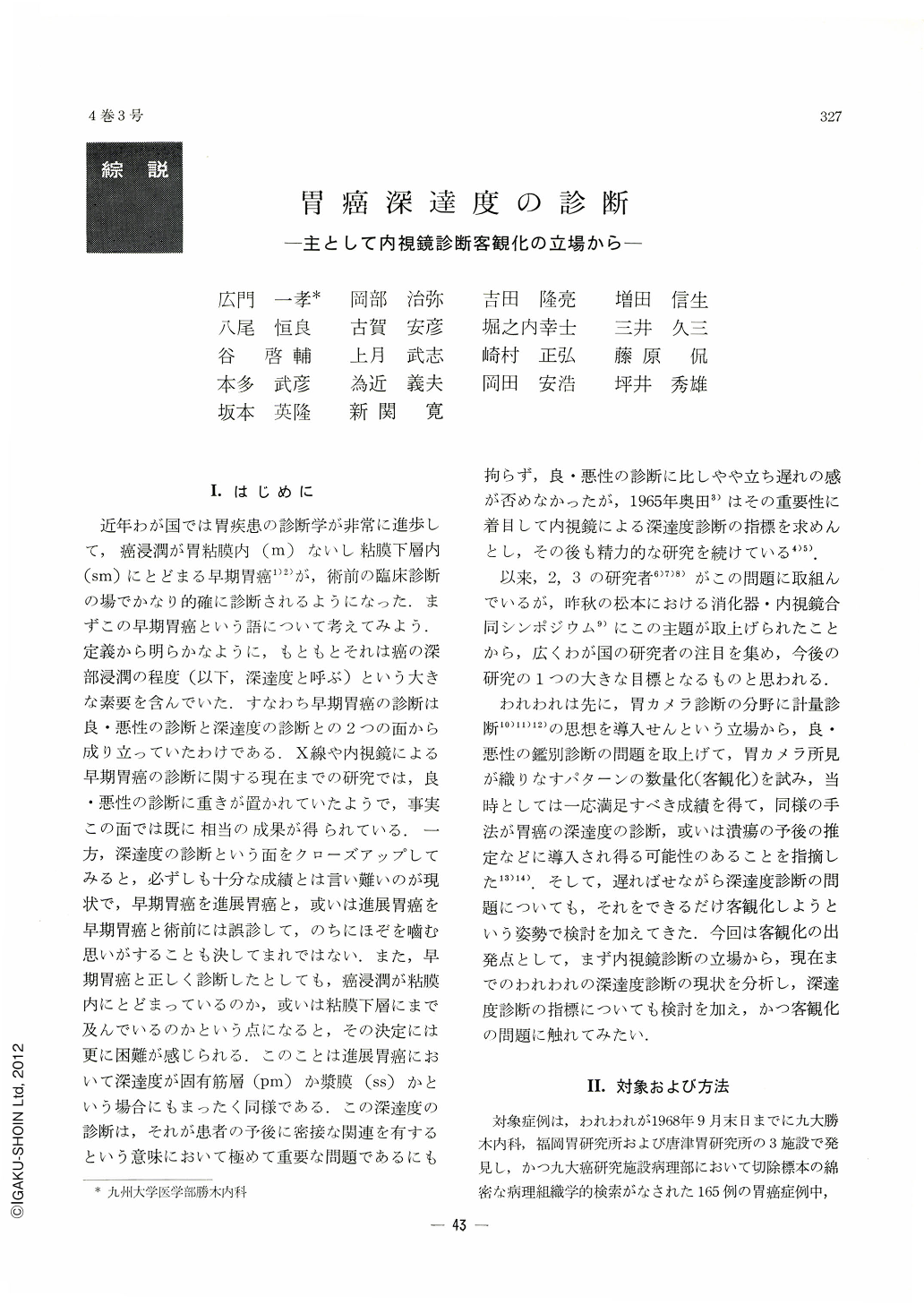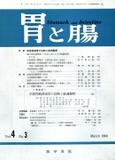Japanese
English
- 有料閲覧
- Abstract 文献概要
- 1ページ目 Look Inside
Ⅰ.はじめに
近年わが国では胃疾患の診断学が非常に進歩して,癌浸潤が胃粘膜内(m)ないし粘膜下層内(sm)にとどまる早期胃癌1)2)が,術前の臨床診断の場でかなり的確に診断されるようになった.まずこの早期胃癌という語について考えてみよう.定義から明らかなように,もともとそれは癌の深部浸潤の程度(以下,深達度と呼ぶ)という大きな素要を含んでいた.すなわち早期胃癌の診断は良・悪性の診断と深達度の診断との2つの面から成り立っていたわけである.X線や内視鏡による早期胃癌の診断に関する現在までの研究では,良・悪性の診断に重きが置かれていたようで,事実この面では既に相当の成果が得られている.一方,深達度の診断という面をクローズアップしてみると,必ずしも十分な成績とは言い難いのが現状で,早期胃癌を進展胃癌と,或いは進展胃癌を早期胃癌と術前には誤診して,のちにほぞを噛む思いがすることも決してまれではない.また,早期胃癌と正しく診断したとしても,癌浸潤が粘膜内にとどまっているのか,或いは粘膜下層にまで及んでいるのかという点になると,その決定には更に困難が感じられる.このことは進展胃癌において深達度が固有筋層(pm)か漿膜(ss)かという場合にもまったく同様である.この深達度の診断は,それが患者の予後に密接な関連を有するという意味において極めて重要な問題であるにも拘らず,良・悪性の診断に比しやや立ち遅れの感が否めなかったが,1965年奥田3)はその重要性に着目して内視鏡による深達度診断の指標を求めんとし,その後も精力的な研究を続けている4)5).
以来,2,3の研究者6)7)8)がこの問題に取組んでいるが,昨秋の松本における消化器・内視鏡合同シンポジウム9)にこの主題が取上げられたことから,広くわが国の研究者の注目を集め,今後の研究の1つの大きな目標となるものと思われる.
われわれは先に,胃カメラ診断の分野に計量診断10)11)12)の思想を導入せんという立揚から,良・悪性の鑑別診断の問題を取上げて,胃カメラ所見が織りなすパターンの数量化(客観化)を試み,当時としては一応満足すべき成績を得て,同様の手法が胃癌の深達度の診断,或いは潰瘍の予後の推定などに導入され得る可能性のあることを指摘した13)14).そして,遅ればせながら深達度診断の問題についても,それをできるだけ客観化しようという姿勢で検討を加えてきた.今回は客観化の出発点として,まず内視鏡診断の立場から,現在までのわれわれの深達度診断の現状を分析し,深達度診断の指標についても検討を加え,かつ客観化の問題に触れてみたい.
The present status for estimation of the depth of cancer involvement as well as dependable findings for its index is studied in this papar from the standpoint of endoscopic diagnosis, by examining 139 cases of gastric cancer, 69 of which belong to early cancer X-ray and the other 70 to advanced one. All these cases have ample evidence of both and endoscopy films to sustain retrospective analysis.
1) In cases of type Ⅰ early gastric cancer and Borrmann Ⅰ type advanced cancer, five out of six were correctly diagnosed by endoscopy. Two cases of Ⅱa type early gastric cancer were likewise well differentiated. As for Ⅱa+Ⅱc type early cancer and Borrmann Ⅱ and Ⅲ type advanced cancer, 43 in 47 cases proved to be correct in their diagnosis. The remaining four early gastric cancer cases were all mistaken for advanced one due to overestimation of extensive submucosal cancer invasion. Regarding Ⅱc+Ⅲ and Ⅲ type early gastric cancer as well as advanced one of similar types, exact differentiation was made in 60 cases out of 84, or 71%. It is noteworthy that 32 cases out of 51, or only 63% were correctly discriminated in Ⅱc+Ⅲ type early gastric cancer. Diagnostic difficulties seem to be more manifest in this type of cancer for estimation of the depth of cancer invasion.
2) In early gastric cancer of Ⅰ and Ⅱa+Ⅱc types as well as advanced cancer of Borrmann Ⅰ, Ⅱ and Ⅲ types, close correlation is found between the size of tumor and the degree of cancer infiltration, and the former may be used as an index for measuring the depth of cancer invasion. No such correlation is seen in Ⅱc, Ⅱc+Ⅲ and Ⅲ type early gastric cancer and similar types of advanced cancer.
3) In type Ⅱc gastric cancer, 17 out of 18 endoscopically confirmed cases proved to be early gastric cancer, while in type Ⅲ cancer, allb ut two in 15 endoscopically verified cases, or 87%, proved to be advanced one. It is thus presumed that there is a close connection between endoscopic diagnosis of each of these types and the estimation of the depth of cancer invasion.
4) Frequency of positive endoscopic findings in each type of gastric cancer in two stages, early and advanced, is studied stochastically, in order to seek any dependable index for the differentiation between early and advanced gastric cancer. In cases of Ⅱc+Ⅲ type cancer, both early and advanced, positive endoscopic findings, that are of help for separating early from advanced cancer, is so scarce that diagnosis of the depth of cancer involvement is very difiicult.
5) Necessity and availability are discussed in this report of objectification in handling information leading to endoscopic diagnosis; introduction of stochastic method is a must and is a great help for due estimation and coordination of obtained endoscopic findings.

Copyright © 1969, Igaku-Shoin Ltd. All rights reserved.


